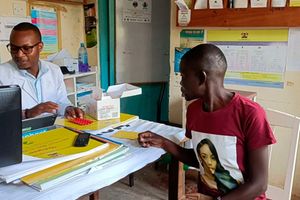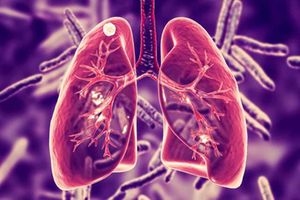WHO distributes new drug to fight multi drug resistant TB as MPs meet in Nairobi to discuss disease

This file photo shows a sample of TB vaccine.
The World Health Organisation (WHO) has added pretomanid to its essential list of medicines in the fight against tuberculosis (TB).
TB is the ninth leading cause of death worldwide and the leading cause of death from a single infectious agent, surpassing HIV/Aids, according to the WHO.
“Over 25 per cent of TB deaths occur in the African region, the emergence of multidrug-resistant TB poses a major health security threat and could risk gains made in the fight against TB,” the global health body observes.
Pretomanid (PA), previously known as PA-824, is a new oral anti-mycobacterial drug recommended by the WHO as part of a six-month, all-oral combination regimen to treat people with rifampicin-resistant, multidrug-resistant (MDR) or pre-XDR (extensively resistant) tuberculosis (TB).
According to Dr Mel Spigelman, CEO of the TB Alliance —a non-profit organisation dedicated to finding faster-acting and affordable drugs to fight TB — this is a critical step towards optimising universal access to the BPaL and BPaLM regimens for patients suffering from drug-resistant TB.
"Several countries use the EML to prioritise medicines for use in their national health systems. With this listing, the novel six-month regimens receive further endorsement on the path to improved outcomes for all eligible patients, replacing older, toxic and often ineffective combinations that required up to 18 months of treatment, sometimes longer," said the CEO.
"We are encouraged by the fact that 109 countries have already procured pretomanid. As we continue to develop the next generation of TB treatments, the TB Alliance remains committed to ensuring that any treatment we develop is accessible to every person who needs it - this listing is an important milestone in that process," he added.
This comes as the Global TB Caucus, an international network of 2,500 parliamentarians in more than 150 countries driving the political will to end TB, gathered in Nairobi on Thursday for the two-day Africa TB Summit 2023, ahead of the United Nations High-Level Meeting (on Universal Health in New York in September this year, which will provide an opportunity for countries and stakeholders to reinvigorate progress towards achieving health for all.
“In 2021 alone approximately 1.6 million died from TB globally. Kenya is on the list of the countries with a high TB burden globally and among the 30 countries that contribute to 80 per cent of the global TB burden. In Africa, Kenya ranks fourth after South Africa, Nigeria and Ethiopia in that order, and even with such a ranking, the country has continued to make great strides in the fight against the disease, recording a tremendous reduction in TB-related deaths from about 33,000 TB-related deaths in 2019 to 21,000 in 2021, according to the latest WHO global TB report," Ms Evaline Kibuchi, a public health advocate and chief national coordinator of the Stop TB Partnership-Kenya, told parliamentarians from around the world.
Although Kenya has made great progress, about 50 per cent of people infected with the disease remain undiagnosed. This poses a great danger because they continue to infect others, thus risking death if those infected remain undiagnosed and untreated".
According to the TB prevalence survey conducted in 2016, men are twice as likely to be infected as women.
This makes the country one of the 30 high-burden countries for both TB and HIV in the world, according to the WHO, and why it is one of 11 other high-burden countries prioritised last year for rapid roll-out of the latest package of innovations.
Last year, according to Dr Nazila Ganatra, head of strategic public health programmes at the Ministry of Health, the incidence of TB was estimated at 140,000 people, while the incidence of drug-resistant TB was estimated at 2,500.
"Last year, the ministry, through the National TB Programme, diagnosed and started treatment for 77,854 people with drug-susceptible TB and another 804 with drug-resistant TB. Roughly speaking, 77,000 people represents a coverage of just over 50 per cent, which means we need to cover 40 per cent of people with TB," Dr Ganatra said.
But it is not all doom and gloom, as Ms Kibuchi noted that the country is among the few on the list of high-burden countries that have met and exceeded the 2020 targets for reducing both TB deaths and new cases.
"Other countries that have achieved this include Eswatini, Togo, Tanzania and Zambia."
To maintain the gains made in fighting the epidemic, she explained that it is necessary to maintain community engagement by supporting them to continue their work on TB.
Dr Ganatra also revealed that the government has started rolling out the Artificial Intelligence (AI)-enabled digital X-ray, a portable device that will be used primarily to screen patients in high-risk groups and hard-to-reach areas.
"These digital CXRs (chest) are also capable of interpreting X-ray results using computerised technology and are therefore very useful where radiologists are not readily available," Dr Ganatra added.
She further disclosed that the Ministry of Health will distribute 38 Truenat machines to 33 counties, eight digital CXRs to seven counties and digital adherence technology, which will help improve adherence to TB treatment. They will be distributed to 186 facilities in Nairobi County.
Dr Eliud Mwangi, Kenya country director for the Elisabeth Glasier Foundation, told lawmakers that Africa has the highest burden of children with TB — 240,000.
"Contact investigation has been confirmed as a critical intervention for paediatric TB management, as it is a key gateway for both case detection and implementation of TB prevention, and its introduction and scale-up should be prioritised by national TB programmes.
Reaching child contacts and retaining them in care is the greatest challenge, and therefore advocacy and careful planning of adequate resources, especially human resources; and strong processes for managing and coordinating contact tracing activities are needed," he said.





